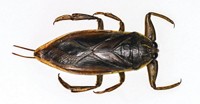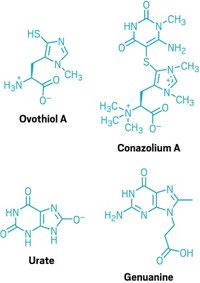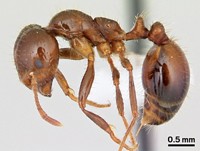Advertisement
Grab your lab coat. Let's get started
Welcome!
Welcome!
Create an account below to get 6 C&EN articles per month, receive newsletters and more - all free.
It seems this is your first time logging in online. Please enter the following information to continue.
As an ACS member you automatically get access to this site. All we need is few more details to create your reading experience.
Not you? Sign in with a different account.
Not you? Sign in with a different account.
ERROR 1
ERROR 1
ERROR 2
ERROR 2
ERROR 2
ERROR 2
ERROR 2
Password and Confirm password must match.
If you have an ACS member number, please enter it here so we can link this account to your membership. (optional)
ERROR 2
ACS values your privacy. By submitting your information, you are gaining access to C&EN and subscribing to our weekly newsletter. We use the information you provide to make your reading experience better, and we will never sell your data to third party members.
Atmospheric Chemistry
Newscripts
An air of sweat and a fang-tastic meal
by Megha Satyanarayana
June 15, 2019
| A version of this story appeared in
Volume 97, Issue 24
Sweaty walls

In an art museum, it’s what’s on the walls that counts. But what if what’s on the walls includes stuff like sweat by-products and nail polish remover?
Lactic acid and acetone were some of the compounds that a group of air-quality researchers tracked floating around a Colorado art museum. Good air is important in the effort to preserve art, but some chemicals are just a little “stickier” than others, says Demetrios Pagonis, one of the chemists at the University of Colorado Boulder who led the study (Environ. Sci. Technol. 2019, DOI: 10.1021/acs.est.9b00276).
“We think this happens on all indoor surfaces,” Pagonis tells Newscripts, listing places the team has examined—homes, classrooms, the weight room at the university gym. “A lot of molecules stick to surfaces indoors before they get ventilated to outdoor air.” And it just so happens that painted walls are a major sink for volatile organic chemicals, more so than his team thought, Pagonis says.
To track the icky stickies, the research team placed different analytical instruments throughout a gallery at the University of Colorado Art Museum. Every few minutes, the machines took a tiny gulp of air, and over a 6-week period, the scientists measured what was in those samples.
One of the key findings, Pagonis says, is that most of the volatile organic compounds they detected escaped to the outdoors long before they could be oxidized or react in other ways.
“What we found is that the indoor chemistry is quite slow,” Pagonis says. The chemicals they were tracing weren’t becoming part of reactions as much as they were leaving the gas phase. This is how lactic acid, found in sweat, ends up on walls, he says, adding, “It’s not like your walls are physically caked in these molecules.” But the findings do give air-quality researchers an idea of how different chemicals move indoors and how they end up outside. Humans, with our deodorants, shampoos, paints, and cleaners, are significant contributors to poor outdoor air quality. Even the stuff that gets stuck to walls eventually finds its way out, Pagonis says.
In case you’re worried that the look on Van Gogh’s self-portrait is one of concern that he is surrounded by nasties that will corrode his likeness, Pagonis says that museums often adhere to stringent air-quality standards. “None of what’s stuck to the walls is a concern to art,” Pagonis says.
That’s something Mona Lisa can smile about.
Rattle snack

The eerie discovery of an entire snake fang in dried-up poop found in southwest Texas suggests that about 1,500 years ago, someone living in that era ate a rattlesnake, whole.
Maybe this person was superhungry, says Elanor Sonderman, the Texas A&M University archaeologist who led the analysis of the desiccated feces. Or maybe it was a dare, but in a time when eating snakes typically involved removing the head, the rattle, and the skin, the discovery of the fang, bones, and scales in the feces suggests something ritualistic was going on (J. Archaeol. Sci. Rep. 2019, DOI: 10.1016/j.jasrep.2019.03.032).
“We know that snakes are revered in the culture and ethnography of these groups,” she tells Newscripts about people who once lived near Conejo Shelter in southwest Texas, pointing out that early rock art in the area features snakes. But eating the head of the beast, she says, is unusual behavior.
Even if the researchers can’t definitively say that the rattle snack was part of a ritual, Sonderman is nearly certain that the critter was a western diamondback rattlesnake, a sometimes aggressive species native to the Southwest and parts of northern Mexico. Its venom is toxic, containing a slew of enzymes that chew up proteins. A diamondback bite is painful and often comes with extensive tissue damage as the proteases in the venom work their way through blood.
Further study of the feces indicates that the snake eater lived in an area where there were no large animals to hunt. People subsisted on rabbits, mice, lizards, and fish. Sonderman says that while studying specimens from this region, she and others have often found whole femurs of mice, plus fur. “It seems like it must have been a terrible existence, but there was enough freedom of movement and joie de vivre to make all this rock art,” she says. “Clearly it was working for them.”
Megha Satyanarayana wrote this week’s column. Please send comments and suggestions to newscripts@acs.org.





Join the conversation
Contact the reporter
Submit a Letter to the Editor for publication
Engage with us on Twitter